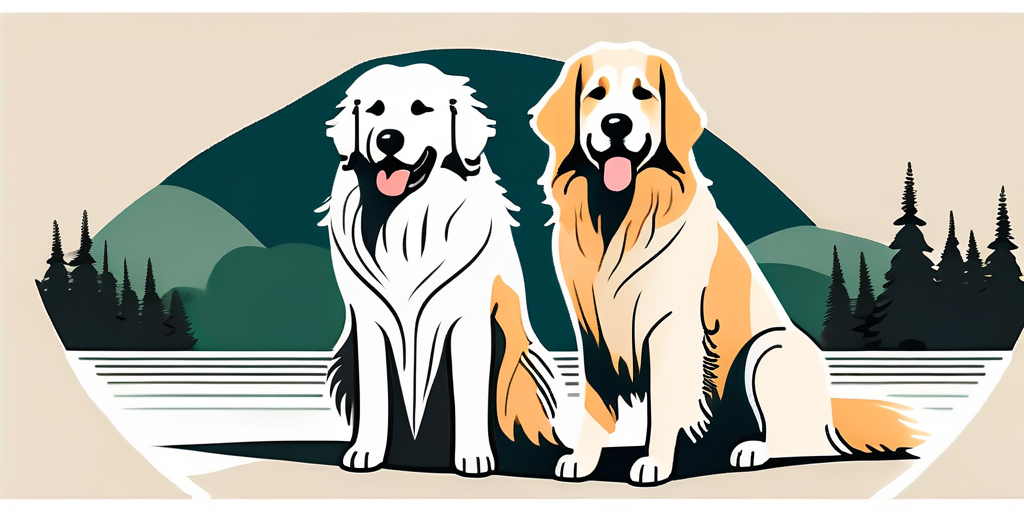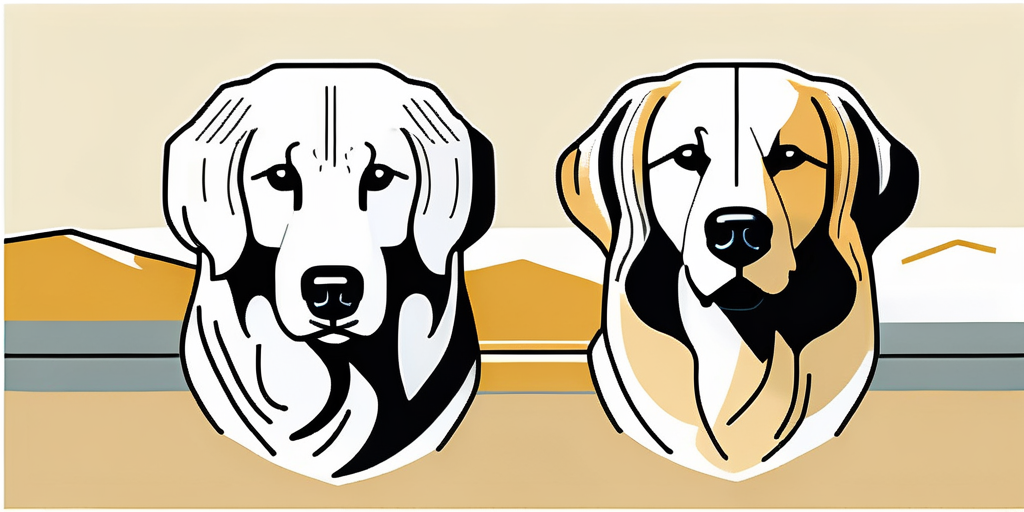Are you considering adding a new furry friend to your family? Two popular breeds that often come up in the conversation are the Great Pyrenees and the Golden Retriever. While both breeds have their unique traits and charm, it’s important to understand their similarities and differences to determine which one would be the best fit for your lifestyle and preferences. In this comprehensive comparison, we will delve into the key aspects of these breeds to help you make an informed decision.
Understanding the Breeds
Origin and History of Great Pyrenees
The Great Pyrenees, also known as the Pyrenean Mountain Dog, has a rich history that dates back centuries. These majestic dogs were originally bred to guard livestock, especially sheep, in the Pyrenees Mountains of France and Spain. Their strong protective instincts and impressive size made them excellent guardians, capable of warding off predators and intruders.
Great Pyrenees are known for their thick double coat, which helped them withstand the harsh mountain climates. Their coat is predominantly white, which not only gives them a regal appearance but also serves a practical purpose by making them more visible in the snowy terrain where they traditionally worked. These dogs are also famous for their calm and gentle demeanor, especially with children, despite their imposing size.
Origin and History of Golden Retrievers
In contrast, Golden Retrievers have a more recent history. These friendly and highly trainable dogs were developed in the mid-19th century in Scotland. They were bred from a mix of Retrievers, Spaniels, and Setters to create a versatile hunting dog that excelled in retrieving game, both on land and in water. Over time, their exceptional temperament and intelligence made them popular family pets and service dogs.
Golden Retrievers are well-known for their dense and water-repellent golden coat, which not only provides insulation during outdoor activities but also gives them their distinctive appearance. Their friendly and eager-to-please nature makes them excellent companions for various activities, including therapy work and search and rescue missions. Additionally, their intelligence and trainability have made them a top choice for roles in movies and television shows, showcasing their versatility beyond their original hunting purpose.
Physical Characteristics
Appearance of Great Pyrenees
One of the most striking features of a Great Pyrenees is their impressive size. They are large, muscular dogs with a distinctive double coat that keeps them warm in cold weather and protects them from the sun. Their coat is predominantly white, often with markings of various shades. Their deep-set, almond-shaped eyes exude a sense of wisdom and intelligence.

Great Pyrenees have a noble and dignified presence, with a strong build and a characteristic gentle expression. Males typically stand between 27 and 32 inches tall at the shoulder and weigh between 100 and 115 pounds, while females are slightly smaller, measuring between 25 and 29 inches and weighing between 85 and 100 pounds.
Originating from the Pyrenees Mountains in southwestern Europe, Great Pyrenees were originally bred to guard livestock and property. Their thick double coat not only provides insulation from the harsh mountain climate but also serves as protection from predators. These majestic dogs are known for their independent nature and unwavering loyalty to their families. Despite their size, Great Pyrenees are surprisingly agile and graceful, capable of traversing rugged terrains with ease.
Appearance of Golden Retrievers
Golden Retrievers are known for their beautiful golden coat, which is dense, water-repellent, and wavy. Their friendly, expressive eyes are usually dark brown or hazel, conveying warmth and kindness. They have well-balanced bodies with a strong, muscular build, making them agile and capable of a wide range of physical activities.
Males typically stand between 23 and 24 inches tall at the shoulder and weigh between 65 and 75 pounds, while females are slightly smaller, measuring between 21.5 and 22.5 inches and weighing between 55 and 65 pounds.
Originally bred in Scotland in the mid-19th century, Golden Retrievers were developed to retrieve waterfowl during hunting expeditions. Their dense, water-repellent coat and webbed feet make them excellent swimmers, allowing them to retrieve game from water with ease. Known for their friendly and outgoing temperament, Golden Retrievers are popular family pets and are often used as therapy and assistance dogs due to their gentle and intelligent nature. They excel in various canine sports such as agility, obedience, and tracking, showcasing their versatility and eagerness to please.
Temperament and Personality Traits
The Nature of Great Pyrenees
Great Pyrenees are known for their calm and gentle nature, making them excellent family companions. They are fiercely loyal and protective of their loved ones, which includes not only their human family but also other pets or livestock they consider part of their pack. With a Great Pyrenees by your side, you can rest assured knowing they will do whatever it takes to keep you safe.

While they are generally friendly, they can be reserved and aloof with strangers. Early socialization is crucial to ensure they grow up to be well-rounded dogs who can confidently navigate different situations and environments.
Great Pyrenees are also renowned for their independent thinking and strong-willed nature. This can sometimes translate to stubbornness, especially during training sessions. It’s important for owners to establish themselves as firm but loving leaders to earn their Great Pyrenees’ respect and cooperation.
The Nature of Golden Retrievers
Golden Retrievers have a reputation for being one of the most friendly and sociable dog breeds. They adore being around people and thrive in a family environment. Their temperament is usually described as outgoing, intelligent, and eager to please, which makes them highly trainable dogs.
They tend to get along well with everyone they meet, including strangers, other pets, and children. However, their friendliness can sometimes lead to overzealous greetings, so early training is essential to prevent them from jumping or knocking over people in their excitement.
Golden Retrievers are also known for their love of water. Originally bred to retrieve waterfowl for hunters, these dogs have a natural affinity for swimming and playing in bodies of water. Their water-resistant coats and webbed feet make them excellent swimmers, and many Golden Retrievers thoroughly enjoy activities like fetching toys from lakes or splashing around in the ocean.
Health and Lifespan
Health Concerns in Great Pyrenees
Great Pyrenees are generally healthy dogs. However, like all breeds, they are prone to certain health conditions. Some of the common health issues that can affect Great Pyrenees include:
- Hip Dysplasia
- Elbow Dysplasia
- Patellar Luxation
- Autoimmune Disorders
- Bloat (Gastric Dilatation-Volvulus)
Regular vet check-ups, a balanced diet, and providing appropriate exercise can help minimize the risk of these health concerns.
Great Pyrenees are known for their large size and thick double coat, which requires regular grooming to prevent matting and keep their skin healthy. They are a breed that thrives in colder climates due to their thick fur, but owners should be cautious in hot weather to prevent overheating. These dogs are gentle and affectionate, often forming strong bonds with their families.
Health Concerns in Golden Retrievers
Golden Retrievers are generally robust and healthy dogs. However, they are prone to certain health conditions, including:
- Hip Dysplasia
- Elbow Dysplasia
- Progressive Retinal Atrophy (PRA)
- Subvalvular Aortic Stenosis (SAS)
- Golden Retriever Muscular Dystrophy (GRMD)
Regular exercise, proper nutrition, and regular veterinary care can help ensure your Golden Retriever leads a healthy and happy life.
Golden Retrievers are known for their friendly and outgoing nature, making them excellent family pets. They are highly intelligent and trainable, excelling in activities such as obedience training and agility. Their love for water and retrieving makes them popular choices for activities like dock diving and fetch. Regular exercise is essential for Golden Retrievers to maintain their muscle tone and mental well-being.
Training and Exercise Needs
Training a Great Pyrenees
Great Pyrenees are intelligent dogs, but they can be independent thinkers. This can make training a bit challenging at times. Early socialization and consistent, positive reinforcement training methods are crucial to shape their behavior and prevent any potential issues related to guarding instincts and territorial behaviors.
When it comes to training a Great Pyrenees, it’s important to start socializing your puppy from a young age. Introduce them to different people, animals, and environments to ensure they grow up to be well-adjusted dogs. Exposing them to various situations will help them become more confident and less likely to develop fear or aggression towards unfamiliar things.
- Start socializing your Great Pyrenees puppy from a young age. Introduce them to different people, animals, and environments to ensure they grow up to be well-adjusted dogs.
- Use positive reinforcement training techniques, such as treats, praise, and rewards, to motivate and encourage your Great Pyrenees during training sessions. These dogs respond well to positive reinforcement and will be more willing to learn when they associate training with positive experiences.
- Focus on teaching basic obedience commands, such as sit, stay, and come, before moving on to more advanced commands. Building a strong foundation of obedience will help establish you as the leader and make it easier to manage their independent nature.
- Ensure your Great Pyrenees gets plenty of mental and physical exercise to keep them stimulated and prevent boredom-related behavior problems. These dogs are known for their endurance and love for outdoor activities, so regular walks, hikes, and playtime in a secure area are essential for their well-being.
Training a Golden Retriever
Golden Retrievers are highly trainable dogs that thrive on positive reinforcement methods. They are eager to please their owners, making training a relatively straightforward process. Here are some tips for training a Golden Retriever:
When it comes to training a Golden Retriever, starting early is key. As soon as you bring your puppy home, make sure to enroll them in a puppy training class. This will not only teach them basic obedience commands but also provide an opportunity for them to socialize with other dogs, helping them develop good manners and proper social skills.
- Start training your Golden Retriever puppy as soon as you bring them home. Make sure to enroll them in a puppy training class to learn basic obedience commands and socialize with other dogs.
- Use positive reinforcement techniques, such as treats, praise, and play, to reward good behavior and encourage your Golden Retriever to repeat desired actions. These dogs thrive on praise and will be motivated to learn when they feel appreciated and loved.
- Be consistent and patient with your training. Golden Retrievers are sensitive dogs who respond best to positive reinforcement and gentle guidance. Avoid harsh training methods or punishment, as it can damage their trust and hinder their progress.
- Provide them with daily exercise, such as walks, playtime, and mental stimulation through interactive toys and puzzle games. Golden Retrievers are active dogs that require physical and mental stimulation to prevent boredom and destructive behaviors. Engaging them in activities that challenge their intelligence will keep them happy and well-behaved.
In conclusion, both Great Pyrenees and Golden Retrievers are incredible breeds with their own unique qualities. While the Great Pyrenees is a devoted guardian and family companion, the Golden Retriever is a friendly and sociable dog that excels in various roles, from family pet to therapy and assistance dogs. Consider your lifestyle, preferences, and the specific needs of each breed before making your decision. Whichever breed you choose, you’ll welcome a loyal and loving companion into your life.
Discover More with BreedRead
Deciding between a Great Pyrenees and a Golden Retriever is just the beginning of your journey as a dog owner. At BreedRead.com, we provide a wealth of knowledge to support you every step of the way. From in-depth breed comparisons to tailored care guides, our resources are designed to help you make informed decisions and nurture a loving bond with your canine companion. Don’t miss out on expert insights and tips—subscribe to our free newsletter today and join a community passionate about providing the best for their dogs.

